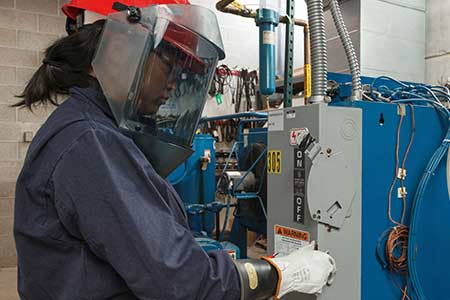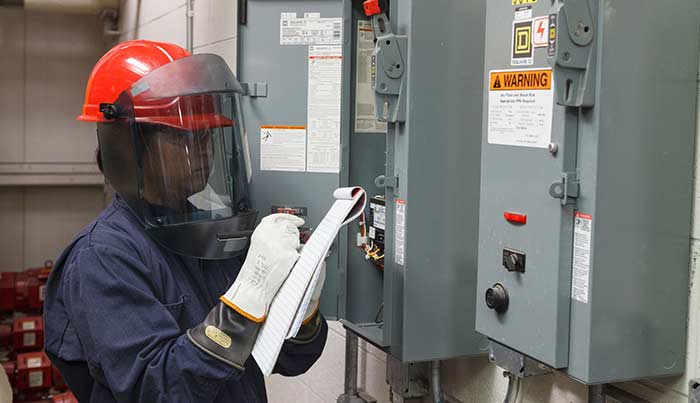Labels for Safety, Visuals and Facility ID Desktop Printers
Labels for Product, Wire and Lab ID Benchtop Printers
Labels for Safety, Visuals and Facility ID Desktop Printers
Labels for Product, Wire and Lab ID Benchtop Printers
Safety and Facility ID Desktop Printers
Product, Wire and Lab ID Benchtop Printers
Barcode Scanner and Printer Kits
Barcode Scanner and Printer Kits
PaintStripe Floor Marking Stencils
Valve Lockouts & Hose Lockouts
Group Lock Boxes & Permit Control
Brady Safety Lockout Tagout Services
Pipe Marker Accessories & Mounting Brackets
Maintenance and Production Tags
Calculators and Assessment Tools
Product Finders and Data Sheets
There’s no getting around it: employees who work on or around energized equipment or machinery are exposed to arc flash hazards daily while on the job. But with the right combination of detection and prevention, these hazards can be identified and avoided, or minimized if an event occurs. That’s where an arc flash risk assessment comes in.
A thorough, accurate arc flash risk assessment ensures worker safety, first and foremost. But beyond that, a sustainably maintained assessment saves money in the long term. Explore key components of this important safety tool, including background, arc flash risk assessment requirements, process and a review of additional compliance needs.
An arc flash is a release of energy through an electrical arc. This happens when an electrical current passes through air between ungrounded conductors or between ungrounded and grounded conductors.
In simpler terms, the effects of an arc flash event mirror that of a bomb. Energy is released in the form of heat, intense ultraviolet and infrared light, blast pressure waves and intense sound waves. Smoke, toxic fumes, molten metal and flying shrapnel may accompany the electrical event. Any person in proximity to an arc flash blast can suffer injuries as severe as burns, collapsed lungs, loss of vision, ruptured eardrums, soft tissue injuries, broken bones or even death.

Arc flash compliance comes from two organizations that are responsible for regulating and providing guidance arc flash risk assessment requirements.
Under 29 CFR 1910.333, OSHA requires employers to identify hazards in the workplace, train their employees to safely work around these hazards, and to provide the proper PPE for the job they are expected to perform. OSHA advises employers to refer to NFPA 70E as the standard for how to meet their requirements.
NFPA 70E informs the OSHA standard and guides facilities to electrical safety and compliance. This includes how to:
An arc flash risk assessment is vitally important to worker health and safety. This critical assessment is required under NFPA 70E and provides four key findings:
These assessment findings then inform the steps, information and procedures you'll need to implement to be compliant under OSHA 29 CFR 1910.333.


Under NFPA 70E, qualified employees must be able to apply their arc flash safety training on the facility floor. Brady’s 8-hour QEW Training brings you into compliance and takes a custom, more-effective approach by incorporating both NFPA guidelines and your companyspecific arc flash requirements. Topics include shock hazards, codes, regulation, definitions, PPE, approach boundaries and labels.

The arc flash risk assessment report will identify:
No matter how big or small, if your facility changes, it could affect or even outdate your assessment. A little work occasionally goes a long way over time. Brady electrical engineers can work with you, on-site or remotely, to assess if facility changes require assessment updates.

Do you have employees who have gone through QEW training in the last three years?
Yes — Brady’s 4-hour Refresher Course is designed for qualified employees who have strong familiarity with NFPA 70E standards and working with electrical equipment.
No — Brady’s 8-hour QEW Training is designed for qualified employees who have:

Arc Flash Assessment Review service dispatches engineers to your site to review your assessment and facility for changes, note affected equipment, and detail next steps.
If it’s been more than five years since your initial Arc Flash Risk Assessment and review, it’s time to have a new assessment performed. In addition to bringing you into compliance, it ensures coverage of your entire facility and everything that may have changed.

It’s time to retrain. Refer to your training records to determine if refresher training and/or initial training is needed.
Comprised of data collection and a series of studies, the arc flash risk assessment identifies arc flash hazards in an electrical system as well as the adjustments, labeling and PPE needed to mitigate them. The following is a high-level overview of the arc flash risk assessment process and conveys key milestones simply and broadly. Your specific assessment will be an in-depth process of data collection, analysis and reporting.
Once complete, all information is packaged up in your report and communicated to employees via Arc Flash Labels and One-Line Diagrams. If you’re interested in a more detailed look at the process for your facility, reach out to a Brady Safety Services expert to discuss the process for your facility.
After an arc flash risk assessment has been completed, it’s important to maintain the accuracy of the data in the study. Changes in utility contribution, installation or removal of machinery and renovations can impact available fault currents. For this reason, arc flash risk assessments are required to be updated in intervals not to exceed five years or when significant changes are made to the system.
This process generally follows four steps:

Having an arc flash risk assessment and labels is only part of arc flash compliance with OSHA, NFPA and the Institute of Electrical and Electronics Engineers (IEEE). Other steps must be taken to be fully compliant.

Employees who face exposure to electrical hazards must be trained in arc flash and electrical hazards in accordance with NFPA 70E. Full-day training is recommended for employees who have not received training in the past. Annual refresher courses can be conducted by the safety department or management at the employee’s facility. Four-hour refresher training courses are available for employees who have received the full-day training more than three years ago.
Certificates should be issued at the conclusion of each class.

Employers must have a written safety program dealing specifically with electrical hazards. This program must be reviewed annually. Documentation of an annual review must be kept. Any changes in industry standards must be implemented in the written safety program. This safety program must also include a pre-job briefing checklist and an energized work permit.

Employees who will be working on, or near, electrical hazards must be provided with PPE appropriate for the job being performed and for the body parts involved in the work being performed. The PPE must be provided at no cost to the employee and shall be maintained and repaired as needed.

When working on, or around, energized electrical equipment, employees must use insulated tools. These tools should be rated at least 1000V. A good practice is to use two-part insulation. This provides a visual indication of outer layer damage allowing the tool to be taken out of service before issues arise.
Some companies rely on third parties, such as electrical contractors, to collect the data needed to complete an arc flash assessment. This method risks employing a contractor who may not be familiar with what data needs to be collected for an arc flash risk assessment, however. Instead, consider dedicated engineers.
A dedicated engineer (or team of engineers) can execute each step of the assessment from start to finish, including data collection, calculations, reporting and label installation. This reduces discrepancies in what is collected versus what is documented. Their in-depth knowledge of the strengths and weaknesses within a system will be conveyed thoroughly at each step.
Further, engineer autonomy creates a more efficient process. Autonomous engineers are familiar with most pieces of equipment and can work alone, tackling all activities designed to be safely completed by one person. This limits the need for a maintenance technician or electrician to accompany the arc flash engineer.
When considering your options for an arc flash risk assessment, always ask the provider to clearly explain your responsibilities as the client. Questions to consider asking include:
NFPA 70E outlines two methods to determine arc flash hazards – the incident energy analysis and the category method. Incident energy analysis is a more thorough and accurate method, making it the preferred choice. Both methods require an accurate short-circuit study to be performed first.
Arc flash risk assessments are complex studies that require a solid foundation in the latest performance standards and the application of that information to the specific work environment. Brady offers a number of ways to maintain electrical safety and compliance, from start to finish and everything in between.

At the core of what we do isn’t products, it’s people. Brady’s team of electrical safety professionals bring decades of experience to your unique project. We’re passionate about what we do and who we do it for because we know our work directly affects lives and livelihoods.
Dedicating internal resources to complete your NFPA arc flash risk assessment can not only be time-consuming, but require an investment in software and arc flash expertise. One miscalculation can result in inaccurate PPE protection, non-compliance and even more time spent on rework. Our team of experts will complete your assessment, provide you with a detailed assessment report, including your single line diagram, and install the correct arc flash labels.
When we complete our work, we pass on all the results and project files to you. After all, it’s your safety and your business, and you should have every tool to succeed.
Under NFPA 70E, qualified employees must be able to apply their Arc Flash Safety Training on the facility floor. Brady offers multiple training options:
If it’s been over three years since your initial arc flash assessment, it’s time to revisit. It could be the difference between making minor updates or performing a costly full new assessment. Brady electrical engineers can work with you, on-site or remotely, to assess if facility changes require assessment updates.
Brady safety labeling and printing solutions do things others don’t in ways they can’t. This includes displaying electrical information in a way that's easier to read from further away, i.e., 240V, Fed from MCC-5.
Discover the Brady Safety Services team difference on your next electrical safety project today.

Better understand arc flash, risk assessments and labeling requirements.
Download
The NFPA 70E gets updated every three years. See the most updated requirements for labeling compliance.
Learn More